
26 minute read
The lights-sparse versus the lights-out
THE LIGHTS-SPARSE VERSUS THE LIGHTSOUT FACTORY
PART 1
The concept of a ‘lights-out’ factory — one in which the requirements for human activity are so minimal that the facility can operate in the dark — has been around for decades, but the digital and automation technologies needed to make it a reality at scale are just now maturing. At the same time, new market trends and perennial issues like questions about labour versus automation are making the realisation of the lightsout factory that much more challenging. Widespread deployment of lights-out factories globally across industries may be years or decades away, but forward-looking manufacturers may seize opportunities today to implement lights-out processes within their conventional and smart factories — making for a ‘lights-sparse’ facility or production line.
The global manufacturing community has long been intrigued by the notional concept of a completely self-sufficient factory in which the only human interactions are the placing of orders and receipt of finished products. Although this blue-sky version is unlikely to completely materialise on a large scale in the near term, it is reasonable to ask which concepts behind autonomous manufacturing might come to fruition. Importantly, any realisation of these concepts must move beyond novelty and prove truly beneficial to manufacturers — improving productivity, quality, sustainability, consistency, safety, profits and certainty. According to a Gartner study, by 2025, 60% of manufacturers will have more than two completely lights-out processes in at least one of their facilities. It is an ambitious expectation for lights-out production.
The lights-out factory or ‘dark factory’ made its way from the pages of science fiction (first popularised in the 1955 short story Autofac, by US author Philip K Dick) to the floors of actual manufacturing facilities in the latter half of the twentieth century. Called lights-out factories because they require so little human intervention that they can operate in the dark, such facilities were attempted in earnest beginning in the 1980s. These early efforts were unsuccessful, but several success stories beginning in 2001 have been widely publicised and discussed. Perhaps the most well known is the FANUC factory in Japan that uses robots to build robots, with no human intervention reportedly for a month or more.
FANUC and other manufacturing companies have demonstrated that the lights-out factory is both possible and profitable — for their
©stock.adobe.com/au/SweetBunFactory
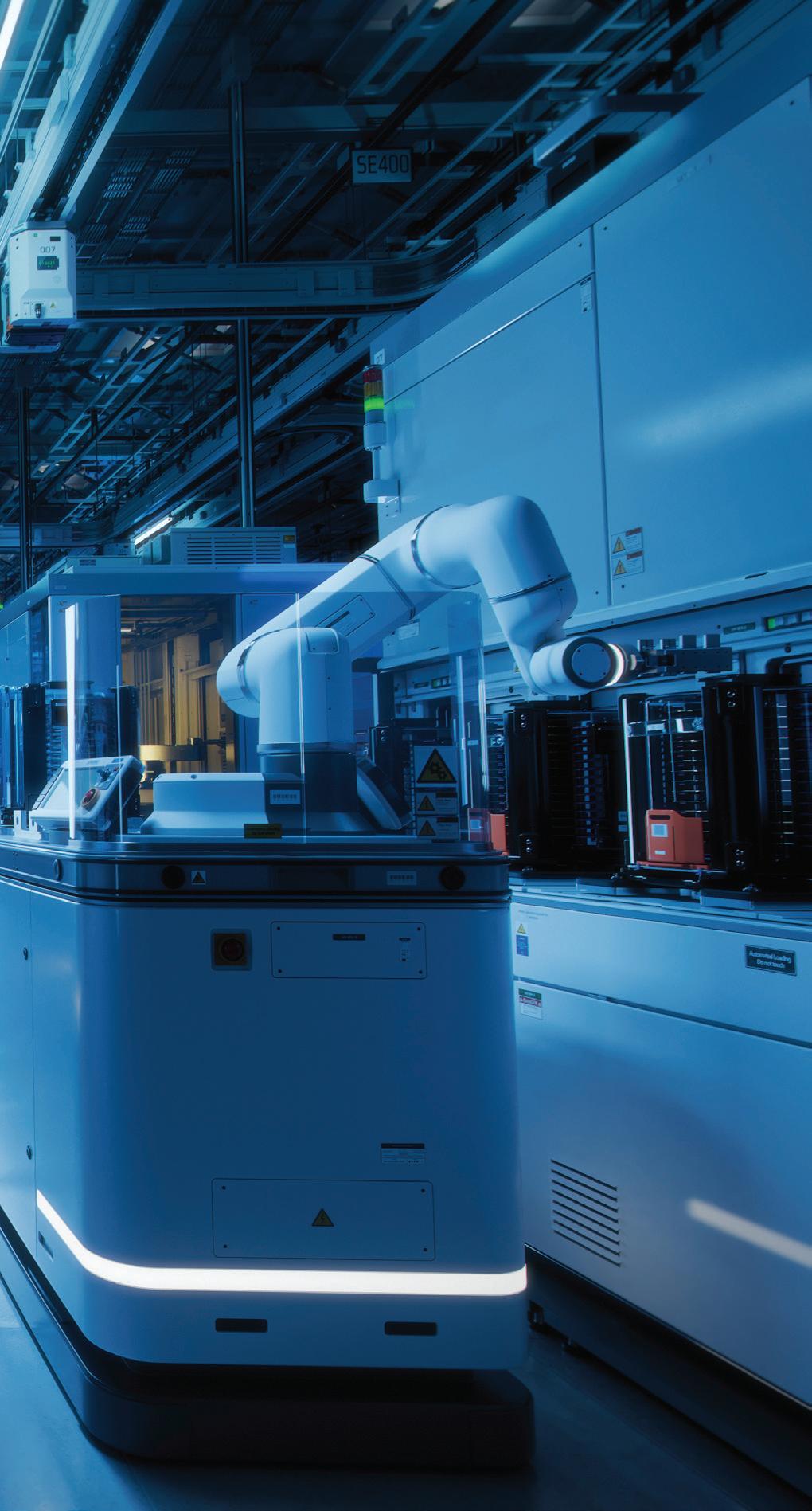
particular applications. The question remains whether it makes sense for your company to build or convert to a lights-out factory, or more likely, convert certain processes within your facility to run lights-out.
For the foreseeable future, converting or building a factory for comprehensive lights-out operation depends on several factors and could become a costly endeavour. A complete lights-out factory must be outfitted with automated guided vehicles (AGVs) and the factory floor infrastructure and floor plan that support them; self-loading and unloading production equipment or robots to complete each of the production steps; self-configuring machines such as CNC machine tools and robots that change out their own end effectors; modular production stations that can be automatically resequenced depending on the particular product being manufactured; vision or other non-destructive automated systems for real-time quality inspections; reconfigurable conveyor belts; pick-and-place machines; advanced networks like 5G; sensors, sensors and more sensors; and perhaps most critical of all, the digital infrastructure and control software capable of scheduling and orchestrating the entirety of the production process, from receipt of raw materials and supplier-made components (which must be quality verified) to packaging and loading finished products onto delivery vehicles.
Traditionally, the type of manufacturing that lends itself to this type of factory is mass production on a fixed schedule. The smaller the lot or batch size a factory is producing, or the more frequently it is required to make new or modified products, the perception is that it is less likely to be a good candidate for full lights-out operation. Automation and digital manufacturing technologies can create this reality but must be incremental to reap the benefits (especially in brownfield facilities where large capital investments are already in place).
It is frequently noted that human beings are the most flexible of production resources. Human intervention remains the most efficient and economical way to implement production changes in a significant majority of manufacturing cases. Today, this human activity is supported by data-generated actionable insights and advanced technologies such as autonomous mobile robots, collaborative robots, edge computing and artificial intelligence/ machine learning. Human-supported lights-sparse production, in which specific operations within the process are conducted at crewless locations within the factory or remotely outside the factory, is a scenario that could make the most of human, digital and automated resources.
Given the challenges of a fully automated factory for most manufacturing endeavours, what makes sense for a much larger segment of manufacturers is to identify specific processes or areas within a facility, or specific blocks of time during production, when crewless operation is both feasible and valuable.
Rather than targeting a complete lights-out factory, most manufacturers are better served to start with lights-sparse manufacturing within their otherwise conventional or smart factory.
At the same time, some manufacturers may want to consider the recently trending concept of the microfactory, with new business models of subscriptions (instead of upfront capital investments) — a small, highly automated manufacturing space that requires a smaller labour force and uses far less energy and materials than a conventional factory. An agile microfactory is capable of high-mix, low-volume business with low cost and high ROI.
These microfactories have the advantage of embracing digital tools from the very beginning. But easy and cost-effective digital technology can be leveraged both by contract manufacturers setting up microfactories (which are small-scale by their very nature) and by corporations with centralised design and geographically dispersed manufacturing — and for that matter, by manufacturers whose operations fall somewhere in between these two models.
Lights-out: new opportunities but also new challenges
Before delving into the means of implementing lights-out manufacturing, it is important to understand the goal — the value of lights-out operations to the manufacturer. Obviously, for a cost-
Majority of Manufacturing Operations
100%
15%
50%
70% 36%
45%
Completely digital, lights-out processes
Human-driven, manual processes only
0%
15%
Today (n = 439)
3%
5 years from now (n = 439)
Source: Gartner
Base: Excludes “Don’t know” responses
Q. What best describes the majority of your manufacturing operations today? Q. And think about five years from now, what do you anticipate your manufacturing operations will look like? Source: 2020 Gartner Smart Manufacturing Strategy and Implementation Trends Survey
Figure 1: Ambitious expectations for lights-out production in 2025.
benefit analysis to weigh in favour of lights-out implementation, the benefits must extend well beyond savings on the utility bill and lightbulb purchases. Examples of some of the benefits enjoyed by those implementing lights-out manufacturing or processes include: • Reduced labour costs: An example of a full lights-out factory, the Chinese e-commerce company JD.com operates a 3700 m2 lights-out warehouse with 20 robots and five technicians instead of the 500 workers a non-robotic operation would require.
Implementing lights-out manufacturing in select areas of a factory would also reduce labour costs, just on a smaller scale. • Less reliance on a labour force: In some parts of the world and in certain industries there are more jobs than there are workers with the requisite skills to perform them. When lights-out manufacturing takes over tedious, repetitive tasks, workers can be trained and reassigned to those tasks better handled with the flexibility and creativity human beings offer. • Reduced error rates: Machines are simply better than human workers at performing repetitive tasks consistently. Machines never get fatigued or distracted, and they perform tasks with very little variation for long stretches. • Material management efficiencies: The application of lights-out technologies to the movement of materials has the potential to shorten dwell time between steps as well as replenishment time.
The result is reduced inventory costs and higher production rates. • Accelerated product lifecycles: Lights-out operations have the potential for accelerated transitions from design to producing the finished goods. Lights-out machinery can be designed to receive digital product design and processing information, selfconfigure and begin production operations much more rapidly than attended machinery.
On the other side of a cost-benefit analysis is the lifecycle of automated equipment and end-of-life disposition towards sustainability. Once automated systems become obsolete or break down beyond repair, what happens to them? In a world pursuing sustainability and working towards a circular economy, manufacturers must consider whether automated equipment enables ‘reduce, re-use, recycle’ benefits while in use, and whether retired equipment can be re-used or recycled itself. Greenfield factories and microfactories can be designed from the very beginning with sustainability taken into consideration.
Enabling technologies
Enabling a lights-sparse facility to be considered today, since a number of technologies have gained capabilities essential to lightsout manufacturing. Robotics Robotics has advanced on numerous fronts, including synchronisation with machines and work-in-progress components, increased range of motion, new gripping technology and much more. In addition to autonomous robots, advancements in cobots do not eliminate human labour, but they make workers more efficient and productive, potentially reducing the number of workers needed on the production floor. Processing innovations Process innovations such as 3D printing and other additive manufacturing (AM) techniques, plus hybrid manufacturing technologies that combine additive techniques with fully automated computer numerical control (CNC) equipment, make net-shape or near-netshape production of components and products possible, with process steps guided through a direct interface with the digital factory.
RATHER THAN TARGETING A COMPLETE LIGHTS-
OUT FACTORY, MOST MANUFACTURERS ARE BETTER SERVED TO START WITH LIGHTS-SPARSE
MANUFACTURING WITHIN THEIR OTHERWISE
CONVENTIONAL OR SMART FACTORY.
Additive manufacturing often begins with a high degree of automation and a reduced number of production steps or production stations — making it more amenable to lights-out operation than some conventional manufacturing operations. Operational technology Operational technology (OT) such as PLCs, edge devices, drivers, sensors, 5G and the IIoT offer accelerated processing speeds that enable automation equipment to rapidly respond to manufacturing conditions. Unattended machines can therefore initiate, proceed, adjust and stop operations that previously required human intervention. Critical enabling technology is the 5G mobile wireless communication standard, which is able to support a wireless data infrastructure within the factory.
Enhanced data-driven operational orchestration technology opens the door to reduced human intervention at the production line. A centralised orchestration control room with a multiexperience user interface, for example, may empower a single operator to oversee multiple machine operations, possibly from a remote location. Conversely, distributed user access to a centralised digital platform means that any authorised stakeholder can remotely access in a secure way the operational insights for decisive actions about any dark process in the manufacturer’s facility. Virtual commissioning Virtual commissioning also enables debugging of automation control logic and PLC code in a virtual environment before download to real equipment. The associated simulation and virtual validation help confirm that automation equipment will work as expected in autonomous mode. AI and ML Artificial intelligence/machine learning enables machines not only to learn process steps but also to improve performance, so that productivity and quality are both enhanced without human intervention. Extended reality Extended reality (XR) technologies, including virtual reality (VR) and augmented reality (AR), enable manufacturers to reduce the tasks an operator must accomplish, and the time spent doing them at the production line.
In Part 2
In Part 2 of this article, the challenges of achieving lights-out or lights-sparse manufacturing will be discussed, along with the digitalisation technology required to achieve them.
Your Global Automation Partner

Monitor Critical Flow and Temperature Conditions
Reduce system downtime with more accurate measurement of critical flow and temperature conditions with the FS+ sensor. Detect leaks or blockages with this easy-to-use sensor. Not only does the FS+ measure the flow rate of liquids in pipes, it also monitors temperature. Plus, no moving parts or rotating sensor components reduce the chance of failure or introducing contamination into the system.
Contact your local sales representative to learn more.
www.turck.com.au 1300-132-566
MASS FLOW METER AND CONTROLLER
The FLEXI-FLOW mass flow meter and controller from Bronkhorst combines the advantages of a through-chip-sensor with bypass technology. The company says the compact thermal mass flow meters and controllers are 35% smaller than traditional instruments, and offer flow ranges up to 20 ln/min.
Due to the sensing technique, the instruments feature stable but fast flow control, with settling times smaller than 150 ms.
FLEXI-FLOW instruments have integrated temperature and pressure sensors and an onboard gas database for high accuracy, even in varying process conditions. With this technology, the instruments are adaptable to many applications through their wide dynamic flow ranges (up to 1:1000). The temperature and pressure signals may provide the user with information about the actual process conditions.
For easy set-up and monitoring of the instruments and the process, Bronkhorst has introduced a USB-C port, optional Bluetooth communication and NAMUR status indication by means of coloured LEDs and digital output parameters. FLEXI-FLOW is available in two preconfigured models, as a built-to-order version or as a customised, multi-channel solution, each including software tools for configuration, diagnostics and predictive maintenance.
AMS Instrumentation & Calibration Pty Ltd
www.ams-ic.com.au

IICA GLADSTONE TECHNOLOGY EXPO
THURSDAY, 28 JULY 2022
©stock.adobe.com/au/weerayut The Institute of Instrumentation, Control and Automation runs expos all around Australia and is excited to be back in Gladstone this year.
The IICA Gladstone Technology Expo will be held on 28 July at the Gladstone Entertainment Convention Centre on Goondoon Street.
The IICA says the expo is a one-stop shop to find out what’s new in the industry, make valuable new business connections and catch up with friends. Everyone is welcome to attend, including electricians, engineers, maintenance managers, production planners, operational staff, instrument technicians, health and safety officers, managers, apprentices and students.
There will be more than 55 exhibitors, including Pilz, Weidmüller, ifm efector, Emerson, Endress+Hauser, Phoenix Contact, SMC, Yokogawa and Teksal Safety to demonstrate the latest in instrumentation, automation and control.
Doors will open at 2 pm and there will be lucky door prizes to be won throughout the day. Attendees are invited to join the IICA and the exhibitors for a complimentary Happy Hour at 5 pm.
Entry to the expo is free and readers can register online at: https://bookings.iica.org.au/bookings/events/event.asp?bookingid=1356.
Registrations before the event day go in the draw to win one of three Amazon Echo Dots.

IICA (Institute of Instrumentation Control & Automation) www.iica.org.au


PUMP TEST MODULES KEEP HPUs IN TIP-TOP CONDITION
Locally made pump test modules help keep hydraulic power units in optimal condition.
Recently HYDAC provided pump test modules to a worldleading resources company to help keep hydraulic power units in optimal condition.
HYDAC Australia’s Adriaan Engelbrecht, based in Perth, said the in-house designed pump test modules were an added feature on the HPUs supplied by HYDAC to the resources company.
Pump efficiency testing automatic
“The HYDAC modules automatically test pump flow rate, pressure levels and overall pump efficiency, among other things,” he said. “All these functions can be fully remotely monitored by the company’s Plant Information Management System.
“The system automatically tests pump efficiency within a specific time period, by automatically running through a test sequence.”
Trend on pumps informs preventative maintenance
The data, generated by running these tests within timeframes and hard parameters provided by HYDAC, gives a performance trend on the pumps, including information on the pump’s condition and whether it has been deteriorating over time.
“This information then informs the preventative maintenance required on the pumps, which is an effective way of maintaining healthy pumps and reducing downtime,” said Engelbrecht. “If set points are exceeded, immediate warnings are sent to necessary personal.”
Timelines
“Last year we manually went through the pump test modules to see if they were operating,” said Engelbrecht. “Just before Easter we assisted the customer with on-site commissioning, and I’m happy to say the module ran smoothly, and implementation was easy.”
HPU monitoring a focal point
Engelbrecht highlighted that HPU monitoring has been a focal point in their development.
“In line with this, the company has a CME module on HPUs and pump test monitoring,” he said. “Overall, the added value that this kit brings is a great company investment to keep HPUs in tip-top condition.”
In addition to pump testing and condition monitoring, HYDAC offers an extensive product range to cover all areas of fluid power. The company also provides on-site reliability audit program, cleanliness solutions for oil and fuel, calibration services, engineering advice, bespoke design, drawings, hydraulic services, technical training, and Industry 4.0 solutions.
HYDAC products are locally engineered, manufactured and tested, and they are under a quality system certified in accordance with ISO 9001. With experience across all electrical areas, involving motor control, process control, automation and AutoCAD, HYDAC is specialised in hazardous area design and installation. The technical training courses offered by HYDAC Australia are nationally accredited and the only ones of their kind in the country.

LONG-DISTANCE LASER SENSOR
The Acuity AR1000 Long-distance Laser Sensor measures targets from 0.1 m up to 30 m without the use of reflective targets. It can work with opaque targets, including glowing steel at temperatures up to 1000°C. The accuracy is typically ±3 mm, depending on the reflectivity of target surface, ambient light and temperature conditions. Dark-coloured targets may decrease the laser’s range and accuracy.
In simple sampling modes, AR1000 self-determines the optimal sampling speed, waiting until it collects enough light to make an accurate measurement. Typical sampling output rates are 6 Hz, but 50 Hz sampling is possible at close ranges to white targets. For long-distance measurements, a larger target with a retroreflective target material can be used to increase the maximum measurement range to 150 m. The AR1000 has a Class 2, red visible laser diode for simple aiming and set-up. The spot size is 5 mm as the light leaves the laser, and the beam has a divergence of 0.6 mrad.
A standard RS232 or optional RS422 serial interface is available for communication with a computer or PLC. The AR1000 also comes with a standard, 4–20 mA analog current loop output. The analog output can be programmed to have a custom measurement span, and the minimum and maximum currents can be set to any points in the laser’s range. The AR1000 has a single limit output for indicating alarms. This can be useful for triggering an external device when a target reaches a set position.
Slentech Pty Ltd
www.slentech.com.au

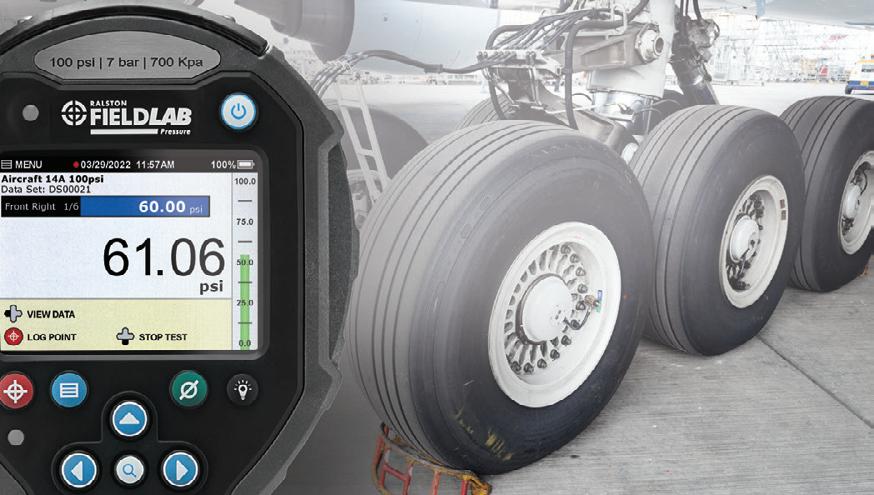
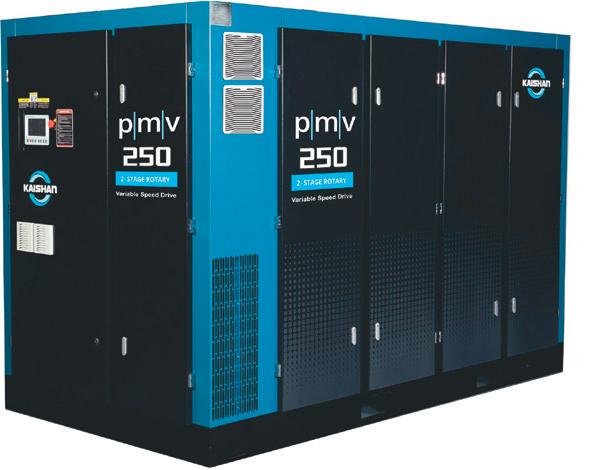
AIR COMPRESSOR
The latest compressor from Kaishan, the PMV 250, utilises permanent magnet motors and variable frequency drive technology. The combination of integrated systemic optimisation of the compressor unit with an advanced permanent magnet motor, SKY 2-stage airend and rapid response, variable speed drive is said to result in a compressor that needs less energy input to drive an efficient compressor while generating greater output.
Rare earth technology gives the permanent magnet motor higher energy efficiency compared to conventional induction motors. PM synchronous torque motors provide faster acceleration and deceleration, a great advantage in compressor applications as they can rapidly vary output to match application demands.
With integral variable speed control, the compressor operates at the level of immediate demand, reducing both input energy needs, machine wear and tear and maintenance requirements. These air compressors are therefore designed to deliver high efficiency and performance in a heavy-duty machine that is also said to possess durability and reliability.
Kaishan offers the PMV compressors in power ranges from 15 to 250 kW to suit the needs of a wide range of industry applications.
Kaishan Australia Pty Ltd
www.kaishan.com.au
HOW DIGITAL THINKING IS UNLOCKING

THE FOURTH INDUSTRIAL REVOLUTION AND ACCELERATING GROWTH OPPORTUNITIES IN TODAY’S WORLD
We’re witnessing the acceleration of the fourth industrial revolution, spurred on by the climate emergency and the shift to net zero industrial practices. Immense challenges remain, yet adopting an innovation mindset, by embracing artifi cial intelligence and cloud technologies, using digital twins and integrating data to operate more effi ciently, will drive future success.
The past two years have demonstrated the power of thinking differently. Industries who invest in the cloud and digital twins while harnessing the potential of artifi cial intelligence — in other words, those adopting a truly digital mindset in response to disruption — are set to succeed.
With the pandemic continuing and the climate crisis intensifying, what began as a survival refl ex has developed as a pathway to a more effi cient, networked and sustainable future. As the World Economic Forum’s annual meeting in Davos convened for the second year in a row, global business leaders are refl ecting on the lessons learned in crisis, and what they mean for our networked world. Schneider Electric would like to take the opportunity to share a few thoughts on how these trends are already shaping the industries of the future.
Integrated data and analytics hold the key to effi ciency
Operational resilience, values-led leadership and data-centric operating models have together created new avenues for growth. Manufacturing and industrial teams across the world have adjusted to different ways of operating. Providing more than just resilience, a digital approach helps to overcome logistical disruption and supports generational shifts in the workforce. As we consider further disruption driven by the climate emergency and which, in time, will dwarf the pandemic, we believe that long-term business success lies in pivoting to data-led operations.
Data-led automation increases productivity
Industry-specifi c artifi cial intelligence (AI) enables companies to work more effi ciently. Pattern recognition from digital twins combined with AI and decision support connects systems so people can work in new ways. Some of Schneider Electric’s smart manufacturing factories in Asia experienced this firsthand because of social distancing measures enforced during lockdowns in 2020. As factories were closed to workers, operations moved to the cloud, and even while functioning remotely, teams safely achieved 30% increases in productivity. The lessons learned in those early days of the pandemic have set new effi ciency standards that are being deployed throughout our global network in 2022.
Digital thinking unlocks ingenuity
Most organizations operate hybrid networks that combine data that is stored both on-premise and in the cloud. Increasingly, companies are looking to share data securely but agnostically throughout their industrial ecosystem. We call this the connected industrial economy. Companies should embrace this to boost effi ciency with suppliers, partners and customers and accelerate growth throughout the value chain. According to Gartner, cloudbased data-sharing is key to integrating working teams and driving the decision-making required to cut carbon emissions, increase profi tability and ensure agility. Aker Carbon Capture is using AVEVA cloud-based software to design leading-edge facilities capturing carbon dioxide from industrial operations.
Digital innovations can bring net-zero closer, quicker
As witnessed during the pandemic, digital operating models drive more effi cient ways of working. Our strategic alliance with EDF in France will deliver the next generation of nuclear facilities and our collaboration with Enel supports their automated plant vision. These are just the beginning of the new, low-carbon power generation industries of the future, enabled by adopting a digital mindset.
In today’s business world, turbulence is one constant. By adopting a digital mindset built on continuous innovation, industries can use data-centric intelligence to become more agile and capture more growth. This digital foundation, enhanced with AI and scaled in the cloud, gives us the confi dence to succeed both in today’s changing world and for tomorrow’s sustainable future.
2D VISION SENSORS
Different parameters can play an important role in vision applications. Pepperl+Fuchs VOS vision sensors are said to offer a simple solution for the majority of requirements. With integrated optics, lighting and electronic analysis, all the key components are housed in one compact device. The lenses can be selected to suit the measurement distance, size of the measurement object and test criteria.
Many models feature an integrated ring light, but external lighting is also available in the form of side or rear lighting or light and dark field illumination. Standard interfaces and a comprehensive range of accessories allow the sensor to be optimally adapted to the application.
Industrial applications require a high degree of flexibility and an equally low susceptibility to errors. Whether in machine and plant engineering, conveyor technology or the packaging industry, the widely applicable VOS 2-D vision sensors are designed to provide fast and reliable measurement data for precise quality control.
Pepperl+Fuchs (Aust) Pty Ltd
www.pepperl-fuchs.com
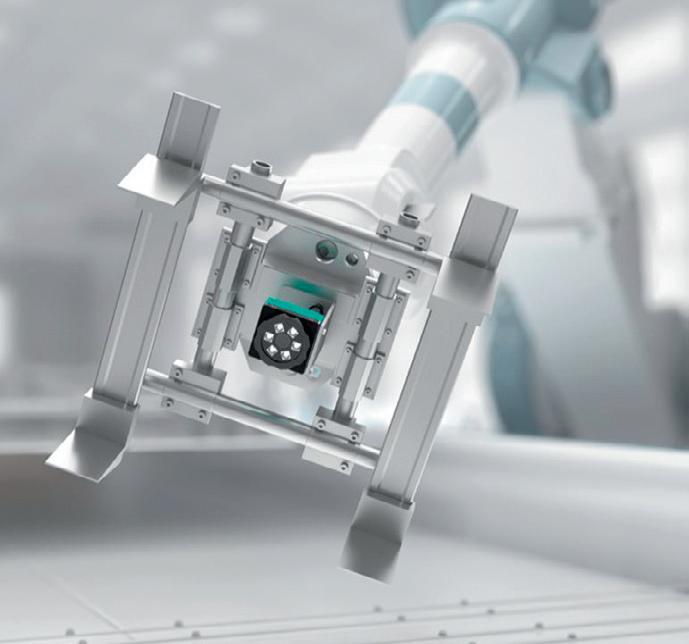
COMPRESSOR
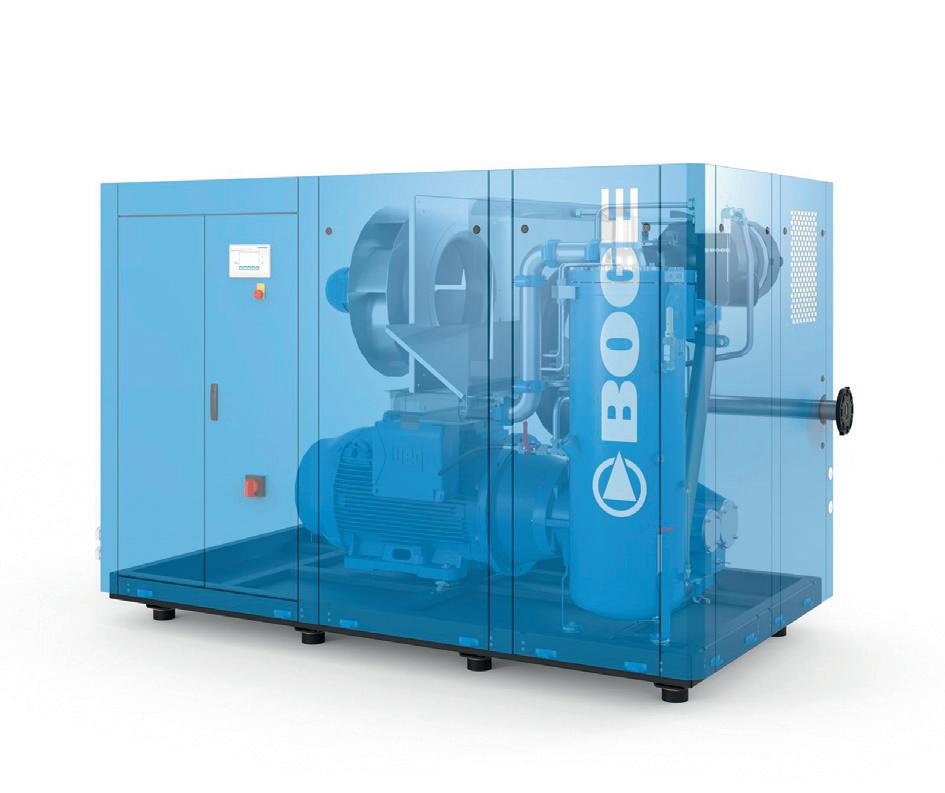
The Boge S-4 air compressor series has been expanded to include additional power ranges.
The latest model — the S 91-4 with an output of 90 kW — is designed to produce free air delivery at low specific power consumption. These efficiency benefits are achieved due to its construction concept, with generously sized components reducing internal pressure losses and a high-efficiency airend.
With its robust design, the direct-drive airend is hermetically enclosed and offers maintenance advantages over belt-driven models, which can suffer from high levels of wear in certain areas of application. When combined with a frequency converter, the speed of the S-4 series compressor can be varied, making it suitable for adapting to the exact compressed air requirements for the task.
Using vibration isolation for individual components and the flow of cooling air, Boge has also been able to reduce noise. To make the best use of the energy supplied to the device, heat recovery can also be added, allowing the heat created by the running of the device to warm service water or for other processes.
For intelligent compressed air management, the modular focus control 2.0 control system and airtelligence provis 3 interlocking control are available.
Boge Compressors Ltd
www.boge.net.au

PROGRAMMABLE AUTOMATION CONTROLLER
ICP Australia has introduced the ICP DAS XP-9371-WES7, a 3-slot metal standard PAC with an Intel Atom E3827 CPU and WES7. The XP-9371-WES7 combines computing, I/O, and operator interface into a single unit and provides a solution for integrating HMI, data acquisition, and control in an individual PAC.
In addition to the Intel CPU, the XP-9371-WE37 is equipped with three I/O expansion slots, and a variety of connectivity options including dual Gigabit Ethernet, VGA, USB port, RS-232 and RS-485 interface. Local I/O slots are available to use ICP’s I-9K and I-97K series I/O modules and remote I/O expansions are available to use the company’s Ethernet I/O modules and RS-485 I/O modules. Since WES7 has the same Win32 API as Windows 7, most popular applications on a desktop can run on WES7-based CPU PC.
In terms of installation the XP-9371-WES7 offers DIN rail and wall mounting, can operate at varying temperatures from -25°C to +75°C, and has redundant power inputs.
ICP Electronics Australia Pty Ltd
www.icp-australia.com.au

VEGA USHERS IN A NEW LEVEL ERA WITH THE 6X® RADAR SENSOR
Traditionally, the search for a suitable radar sensor begins with the question, which frequency would work best for this particular application? 26GHz or 80GHz? Or perhaps 6GHz would be better? This is followed by thoughts about the properties of the media and how it could influence the measurement, as well as the specific installation environment. Furthermore, the temperature range or the presence of aggressive chemicals may give cause for concern. Will a standard process fitting be sufficient, or would special materials that meet the highest requirements be the right choice, if only because the user is not completely sure and wants to be on the safe side? And what else should be considered if the sensor is to measure great distances or be exposed to wind and weather all year round?
These and countless other questions make one thing clear: with such a wide choice, users also have to select the right choice. They have to choose from the large variety of radar sensors that are currently on offer, and because the areas of application are becoming more multi-faceted and processes more complex, the buyer needs a good understanding and overview of what’s on offer on the market. It takes the right know-how, experience and time to avoid making costly bad investments and get a reliable measuring system.
A new certainty: One for everything
Until now, choosing an instrument was a laborious process and often involved a lot of questions and product research. VEGA is now turning this process inside out with its new VEGAPULS 6X.
“Ultimately, it’s not the sensor that counts, but what the user can achieve with it in their individual application,” said Florian Burgert, VEGA product manager. “Just knowing that they’ve chosen the best possible instrument solution, and that they’ll reach their goal faster with it, makes a big difference in their everyday operations.”
With the VEGAPULS 6X, selecting the right frequency or determining the dielectric constant of the medium are no longer obstacles, because choosing the right sensor specifications has become much easier. The new configurator asks for the type of application and then quickly determines which sensor version is required. The entire procedure now consists of just a few mouse clicks, but of course an advisory discussion with a VEGA radar specialist is still a good alternative to the configurator. In any case, the result is unprecedented simplicity for users and a measurement solution that delivers perfect results independently of the media properties, process conditions, vessel shapes and internal installations.
Focusing on the application
Product manager Jürgen Skowaisa sums up in two words the strategy VEGA is pursuing with VEGAPULS 6X: maximum simplification.
“Until now, there were many different sensors that could be used for an application, but today, with VEGAPULS 6X, there is one sensor for all applications,” he said.
Even setup and commissioning, he says, has been reduced to a minimum, requiring now just a few clicks and the input of basic data.
“Our customers can even order a sensor that has been factory calibrated, customer-specific down to the last detail, which only has to be installed and connected. It doesn’t get any easier than that.
“Furthermore, our technology has reached such a high level today that reliable function is no longer the issue,” said Skowaisa. “The only risk now is choosing the wrong sensor.”
Thanks to the new approach with VEGAPULS 6X, VEGA now provides the tools to get the right sensor version for the application in 99% of all cases, while keeping experienced application engineers on standby to help with the special, more difficult applications.
“In the future, the user will no longer have to worry about the technology, frequency or instrument version — the measurement will simply work,” he said.



